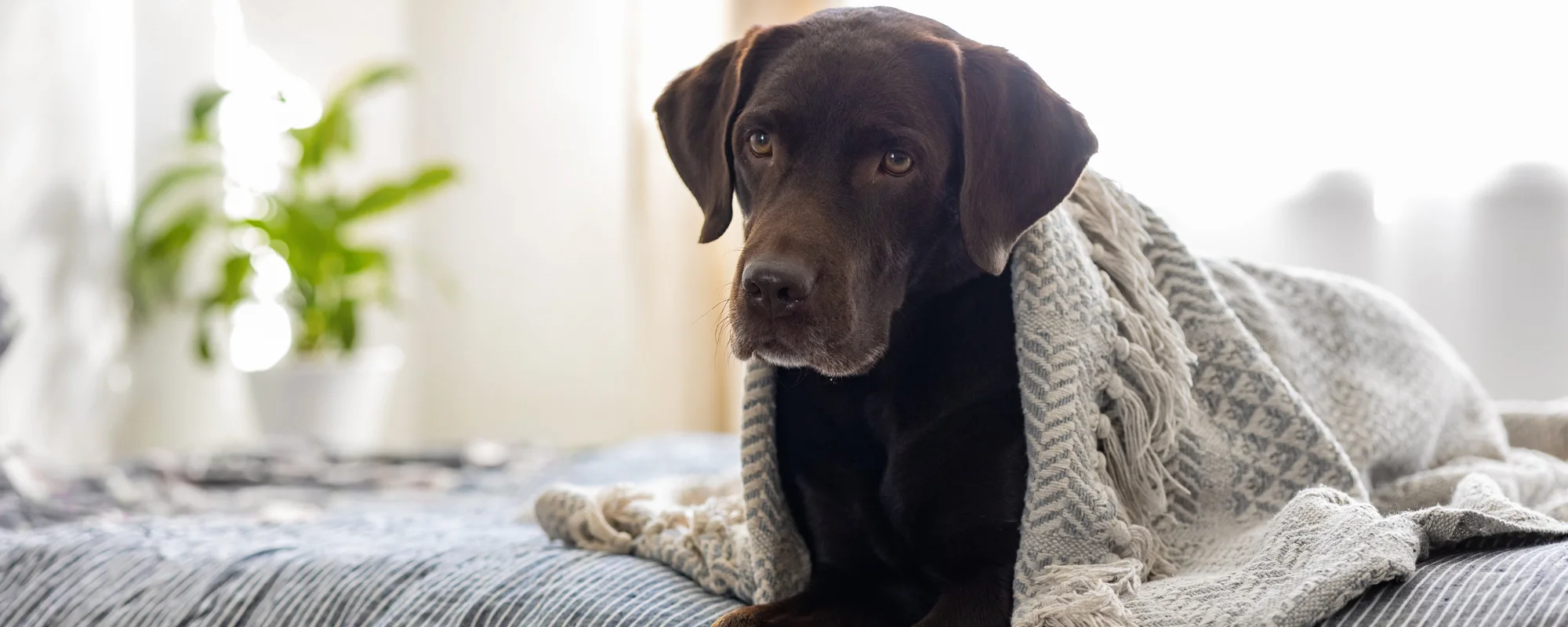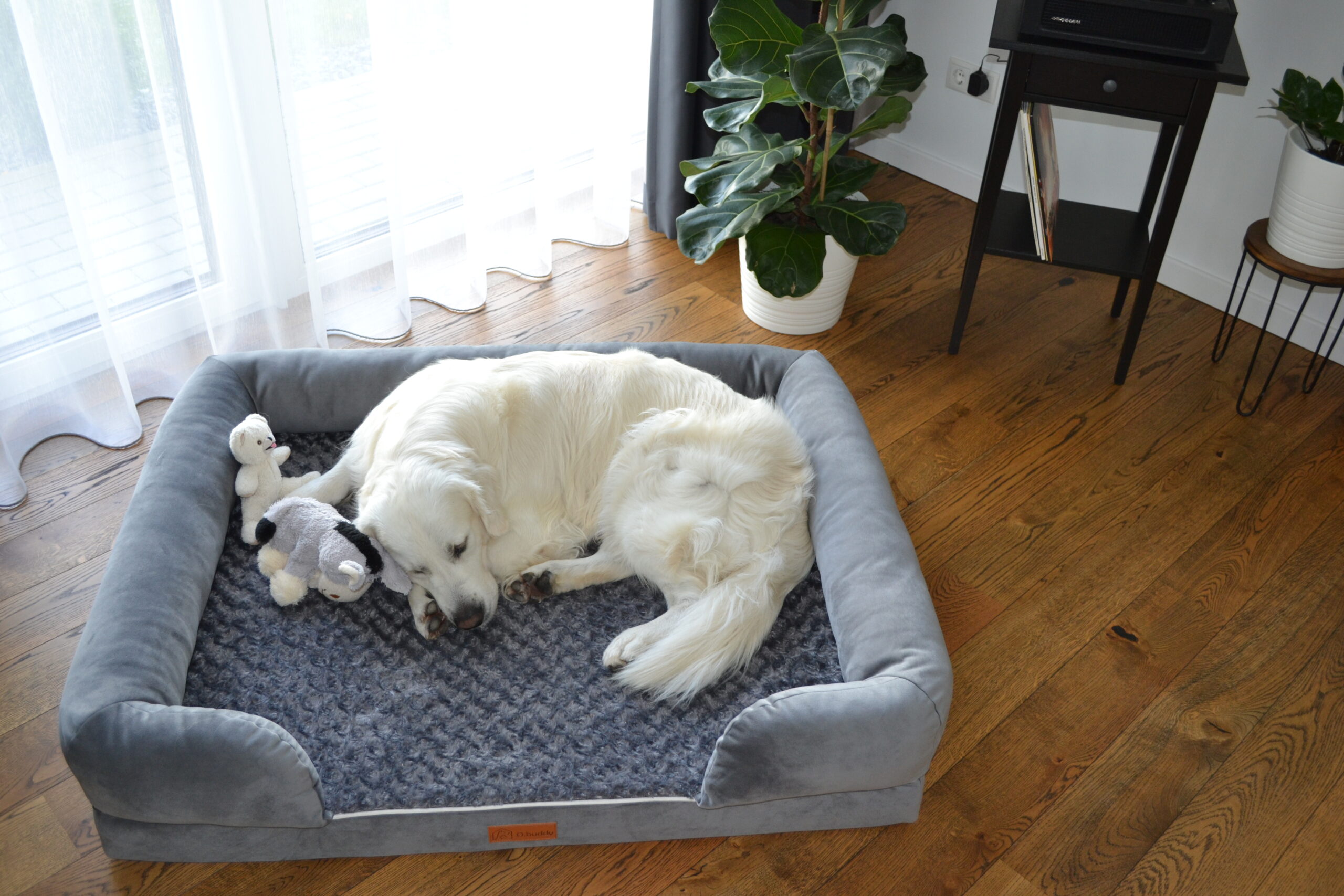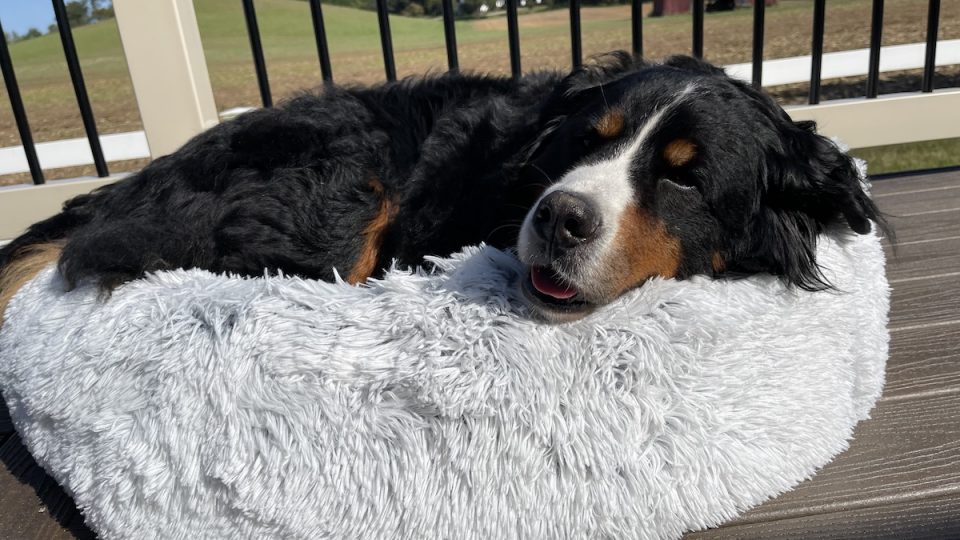How to Choose the Perfect Dog Bed(s): Style, Size, Placement & More


Choosing the right dog bed for your pup can feel like finding a needle in a haystack. With so many types of dog beds on the market, pet parents have a lot of factors to weigh—from a bed’s size and shape to its materials, durability, and level of support. Since a good dog bed contributes to improved sleep and better health overall, it’s an important purchase. We’ve asked the experts to spell out the different styles of dog beds available, plus which dogs they suit best and what kinds of problems they can solve.
What Kinds of Dog Beds Are There?
Choosing the best dog bed for your pup starts with understanding the unique features and drawbacks of different bed types. Here’s a run-down of the main categories.
1. Orthopedic and Memory Foam Dog Beds
Orthopedic dog beds offer the best support for dogs of all stripes—although seniors, large breeds, and dogs with joint issues stand to benefit most. Typically shaped like flat rectangles, the best orthopedic beds are made with a generous layer of true memory foam. This material takes the pressure off your dog’s joints by contouring their body and evenly distributing their weight. Memory foam is also said to improve mobility. Orthopedic beds usually cost more than the average dog bed, but they tend to last longer than flimsier mattresses.

2. Calming Dog Beds
Nest-like calming beds are designed to soothe anxious pets. They’re also ideal for dogs who like to cuddle or sleep curled up. Calming beds often have a rounded donut shape and raised sides that cocoon dogs in a warm center. Other features include soft faux fur reminiscent of snuggling their mother and littermates and a perimeter of plush bolsters, creating a reassuring barrier from outside threats.

3. Dog Crate Beds
Adding a crate bed is one of the best ways to establish your dog’s kennel as an inviting safe space. Fitting in most standard-sized crates, these beds make it easy to get the correct dimensions. Options run the gamut from ultra-thin mats, more akin to a padded blanket, to heavy-duty orthopedic mattresses.
4. Covered dog beds - caves
Warmth and safety are some of the main features of covered bearings. Some beds have loose-fitting blankets for dogs, for those pets that like to sleep under a blanket, while others have more rigid, tent-like hoods. Covered beds are usually preferred by dog breeds that like to 'dig in', such as Dachshunds. They are popular with smaller dogs because they provide a sense of security.
5. Elevated Dog Beds
Raised a few inches off the ground, elevated dog beds make excellent outdoor lounges. The cot-style design keeps them from direct contact with the dusty ground. Plus, the mesh fabric won’t absorb water, and it can be easily hosed off. What’s more, elevated beds maximize air circulation, which helps to keep dogs cool and comfortable. They’re also some of the most durable dog beds you can find. Elevated bed tends to hold up best against heavy chewers. With the fabric secured within a sturdy metal, aluminium, or PVC frame, these beds leave no excess material for dogs to chew.
6. Waterproof and Outdoor Dog Beds
If you have an accident-prone pup or need a bed for lounging in the yard, a waterproof dog bed may be on your radar. Waterproof beds are useful for camping or traveling with your dog, and they come in handy if you have a pup who loves to get muddy. The type of waterproofing you need will depend on how you intend to use the bed. Some mattresses have waterproof inner liners: these are best for indoor use and protecting beds from potty accidents. For outdoor use, opt for a bed with a waterproof outer shell that can be removed and tossed in the wash. When shopping for this type of bed, look for waterproof and water-resistant materials like PVC-backed fabrics, nylon, polyester, plastic, and powder-coated steel.
7. Dog Cooling Mats
For super furry breeds or dogs who overheat easily recommended cooling mats. These beds often take the form of a simple thin pad—but if your dog needs extra support, more substantial orthopedic models are also available. Gel-based cooling mats tend to be the most convenient. Their cooling power activates when your pet sits down—no electricity, water, ice, or refrigeration is required. Their portability makes them especially handy to bring along on summer road trips. You’ll also find cooling mats that use ice trays (which tend to be the coldest) or water.
8. Heated Dog Beds
A heated bed can be a great comfort for dogs who get cold easily, pups who live in cold climates, or pets who like to spend time outside in chilly weather. Heated beds can be either electric or self-warming. Plug-in models are thermostatically controlled, whereas self-warming beds use layers of heat-reflecting material to keep dogs toasty. Typically, electric beds have more effective heat output—but they can be a hazard for pups who love to chew. Some heated beds offer cushy bolsters and ample padding. Thinner, foldable mats, on the other hand, are handy for travel—especially battery-operated models.
How To Match Your Dog to a Bed Type
When it comes to matching your dog to the ideal bed, there are several factors to consider, including your dog’s age, size, body type, breed, and temperament. Your dog’s preferred sleep style is another factor, as some beds accommodate certain sleep positions better than others. Some pups like to sprawl, others are inclined to curl up, and some prefer resting their head on a supportive pillow. This can be a matter of simple preference, or it may point to your dog’s comfort level or body temperature.
Get easy to clean beds for puppies
Ideally, puppy beds will be easy to clean and strong enough to endure less delicate treatment. Recommended durable beds with waterproof liners, as puppies are prone to accidents. Additionally, most puppies will benefit from a comfortable and reassuring bed. “A cozy self-warming bed that cushions the growing bodies of puppies is helpful during their early days being away from their mother. Generally, puppies tend to do well in cave beds, donut beds, and beds with raised sides, so puppy parents should be on the lookout for beds with comforting bolsters, plush mattresses, soft covers, and circular shapes. Keep in mind, too, that puppies may need a bigger bed as they grow (unless you start with a bed that will fit their projected size).
Senior dogs will benefit from memory foam
Older dogs or pups with mobility issues are good candidates for an orthopedic dog bed. These beds can provide relief from arthritis or other age-related pain. They also make it easier for older dogs to stand up. If your senior dog has limited mobility, look for a bed with lower sides. And if they struggle with incontinence, a waterproof liner can protect your investment.
Large dogs need maximum bed support
Like seniors or dogs with joint problems, large dogs can benefit from a sturdy orthopedic bed. Since their joints and muscles experience extra stress, big dogs need a bed that can relieve pressure by evenly distributing their weight. Larger breeds are also more prone to hip dysplasia and spinal issues, making an orthopedic bed ideal. Elevated beds are also worth considering for larger breeds since these beds are supportive and allow for good air circulation. Plus, they tend to be more durable against a bigger dog’s activity.
Thin dogs will want beds with extra padding
Thin dogs will benefit from a bed that provides warmth, safety, comfort, and joint support. Your delicate Greyhound or Whippet may enjoy the insulating comfort of a heated bed, or a bed with cozy bolsters. Without adequate cushioning or padding around their bones, thin dogs can also stand to benefit from a bed with orthopedic support.
Flat-faced breeds will benefit from bed bolsters
Your snub-nosed Pug or flat-faced Frenchie can do well in a variety of beds, but donut beds are especially helpful with breathing. Raised sides give these dogs a place to stretch their necks and lift their heads—an optimal position for unobstructed airways. Brachycephalic dogs also tend to overheat easily, so a cooling bed or an elevated bed could also be a winner.
Anxious dogs will want beds they can hide in
For dogs with chronic or situational anxiety (think: fireworks or noisy guests), the right bed offers a place to retreat and find their zen. Beds marketed as calming beds provide comfort with soft fabrics, round designs, and raised sides. Covered cave beds can also offer nervous dogs a touch of tranquility. Keep in mind that some anxious dogs become destructive when stressed. If this applies to your dog, you might be better off avoiding plush beds that are easily destroyed. A tougher bed and calming toys might be the way to go.

How Big Should Your Dog’s Bed Be?
Size is another important consideration, since a bed that’s too small can limit your dog’s sleep positions, and a bed that’s too big can leave them feeling vulnerable and exposed. Ultimately, sizing your dog’s bed is all about comfort. Big or small, they should be able to comfortably stretch or sleep in any natural position they want within their bed. This usually means choosing a bed that is at least slightly bigger than your dog—even if they’re generally a nester or like to sleep curled up. A dog may like to curl up and sleep, but they still need the option to change positions or move around as they sleep. Most dog bed manufacturers provide a size guide based on weight, but it’s important to measure your dog’s length, too. Measure your dog from snout to tail base, and add a few inches. This should give you a rough guideline for the best bed size. If you have a still-growing puppy, you can either purchase a bed that fits them now—or size up based on how large you expect them to become.
Can dogs share a bed?
There are some scenarios where bed-sharing is a viable option—but only in limited circumstances. It’s usually okay for puppies from the same litter to share since they’re familiar with each other and grow up together. But introducing a new pup to share a bed with an older dog is a different story. The same goes for any adult dogs not raised together from puppyhood. Dogs have preferences, too, and we have to respect their privacy as well. It’s important to remember that dogs are territorial by nature, and bed-sharing can lead to resource guarding and aggression. Each dog should have their own dedicated sleep space available, even if they choose to sleep together. This gives your dog a safe space to go to when they are feeling stressed or anxious.
Where Should You Put a Dog’s Bed?
The best way to know where to place the dog bed is to observe their favourite sleeping spot. Advise is to look for a quiet area of the home with little to no foot traffic. Ideally, it will be placed near other family members—but not directly in the busy center of household life (like the kitchen). Bedrooms and living rooms are usually good landing spots.
How To Clean a Dog Bed
With hair, mud, and lingering wet dog smell to contend with, our dogs’ beds can get seriously icky. And since beds can also harbor germs, routinely cleaning them is a matter of health. Regular washing not only keeps a bed smelling good but also keeps infectious agents away and maintains a dog’s health. So how often should you wash your dog’s bed? Ultimately, this will depend on your dog’s habits and how often they use their bed. If they’re messy, drool a lot, or enjoy playing outdoors in the mud, you may find weekly washing appropriate. If your dog is tidier or doesn’t shed as much, a monthly wash should suffice. (Always check your dog’s bed for cleaning instructions.)
How We Chose
The dog beds featured here were selected based on a combination of our own hands-on testing, a comprehensive look at customer reviews, and interviews with veterinary experts. We prioritized beds with durable materials and thoughtful designs. Additionally, we considered a wide range of canine needs, taking into account different temperaments and sleep preferences. We’re also guided by the experience of living and playing alongside our own much-loved and strongly opinionated pets, who are never stingy with their feedback.
